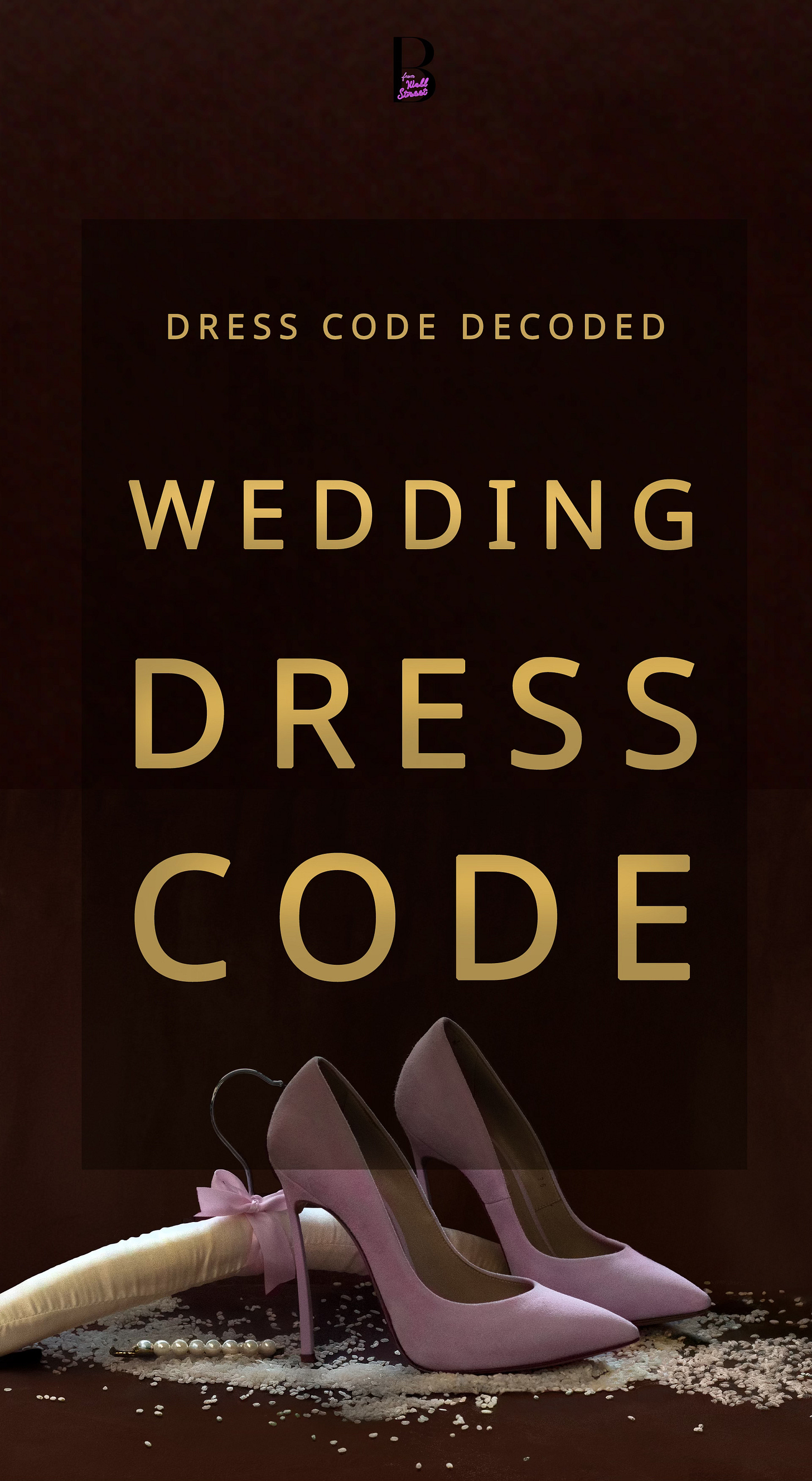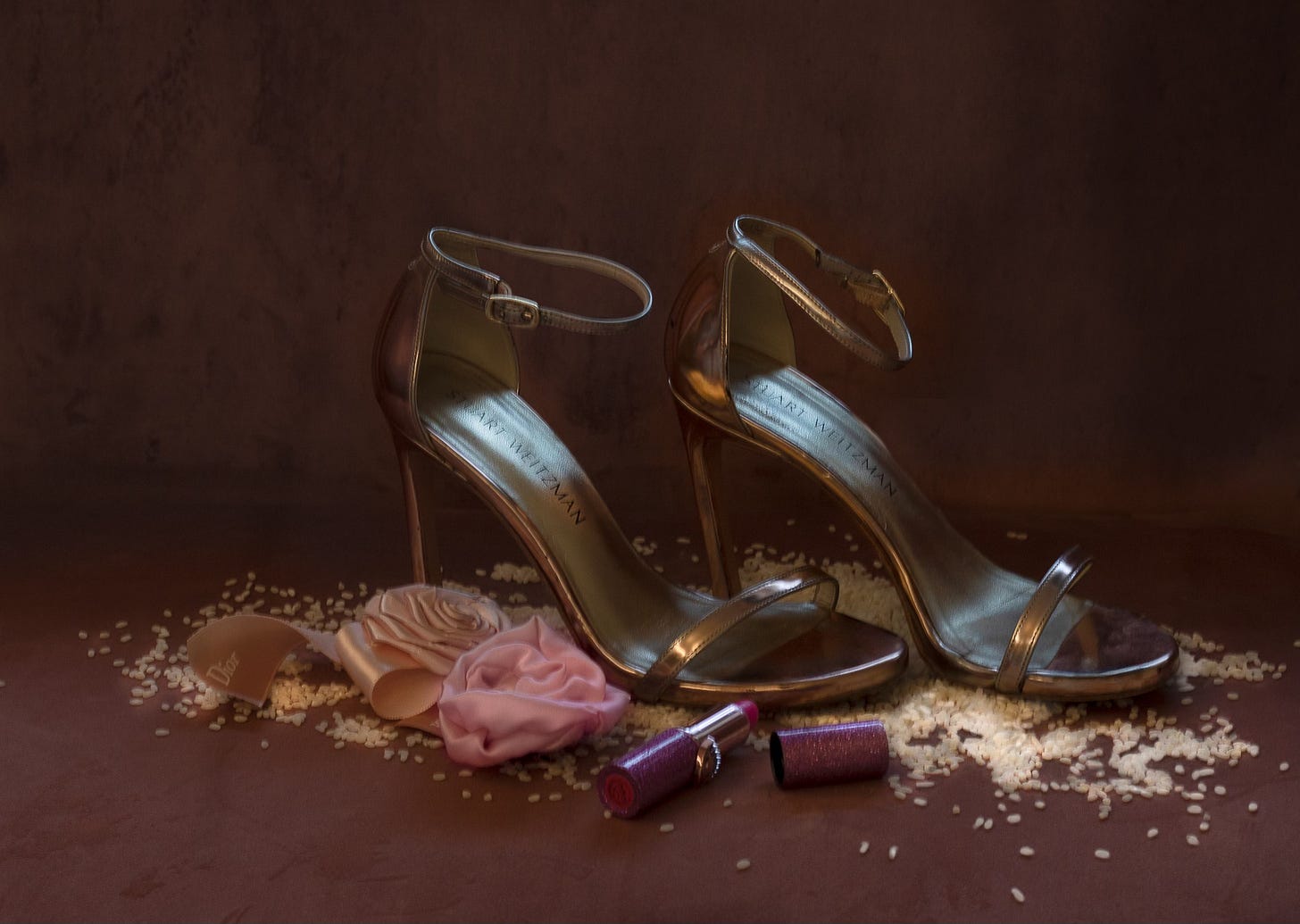Weddings are significant cultural events, and the attire worn by guests plays a crucial role in honoring the couples vision. Adhering to the wedding dress code is considered a fundamental aspect of guest etiquette, demonstrating respect for the couple and their wishes. It shows that guests are invested in making the day as the couple envisioned. However, the variety of dress codes, ranging from traditional formal wear to more relaxed and creative options, can sometimes lead to confusion and uncertainty for wedding guests. It takes two to interpret the wedding dress code. And THERE IS ALWAYS a dress code - even when it’s not written. *We are decoding the unwritten wedding dress codes as well - in the end, so make sure you read through.
OGLAS I get a commission for purchases or clicks made through links in this post.
THE HISTORY OF WEDDING GUEST ATTIRE
Wedding celebrations during the Medieval period were significant political and social events for European nobility, serving as occasions to display wealth and status. Aristocratic families often spent fortunes on their attire, with strict feudal class systems dictating what guests could wear. Nobility and royal wedding attendees adorned themselves in luxurious fabrics like velvet, silk brocade, and damask, accompanied by intricate gold and silver embroidery, fur trimmings such as ermine and sable, and vibrant colors achieved through costly dyes like Tyrian purple. Their ensembles featured multiple layers, elaborate headdresses, and fine jewelry, including gold chains and gemstones. Merchant-class guests opted for quality wool and some silks, fewer layers, and practical yet elegant accessories, while common folk wore simple linen or homespun wool in natural, undyed hues with minimal embellishments. Sumptuary laws regulated wedding attire to maintain social distinctions, prevent extravagance, and protect domestic textile industries.
The Renaissance period (1400–1600) brought increased attention to fashion innovation, leading to elaborate wedding guest attire influenced by national styles. Wealthy guests donned structured gowns, fitted bodices, voluminous skirts, and luxurious textiles in rich colors. Women accessorized with ornate headdresses like French hoods, pearls, and slashed sleeves revealing contrasting fabrics, while men wore padded doublets, breeches, short capes, codpieces, and decorative hats adorned with feathers or jewels. International politics influenced fashion, with figures like Catherine de Medici and Philip II of Spain introducing new styles to foreign courts. By the late Renaissance, the first fashion publications created standardized expectations for wedding attire among European elites.
The Victorian era (1837–1901) marked a pivotal shift in wedding guest attire, introducing traditions that still shape modern dress codes. Early Victorian weddings were intimate affairs, with women wearing dark silk dresses with modest necklines, accompanied by bonnets, gloves, and minimal jewelry. Men embraced morning dress, featuring striped trousers, waistcoats, cravats, and top hats. As mid-Victorian weddings grew more elaborate, formal dress codes became more defined and day weddings required visiting dresses in rich fabrics, while evening weddings called for gowns with lower necklines and dramatic silhouettes. Gloves became longer, and family members often coordinated outfits in complementary colors. Men’s attire followed strict patterns, with morning coats for daytime events and tailcoats for evening occasions.
By the late Victorian era, many modern wedding guest conventions emerged, including strict color protocols - white was reserved for the bride, black for mourning, and red deemed too flashy. Specialized wedding guest ensembles appeared in fashion magazines, cementing the expectation of formal attire. Women wore tailored suits for day weddings and full evening dress for nighttime celebrations, often accessorizing with elaborate hats. Seasonal fabrics dictated outfit choices, with lightweight silks preferred for summer weddings and velvets for winter occasions. Men's attire became standardized, with black morning coats for daytime and white tie attire for formal evening events. The introduction of the dinner jacket (tuxedo) added a less rigid option for evening ceremonies. Boutonnieres became a staple for male guests, reinforcing the idea that wedding attire should demonstrate respect for the occasion while avoiding excessive display. Guides such as The Ladies' Book of Etiquette (1873) stressed the importance of subdued elegance, advising guests to dress fashionably but never overshadow the bride.
CONTEMPORARY WEDDING GUEST EXPECTATIONS (20 and 21st Century)
70s Transition
The dawn of the boho era marked a significant transitional period for wedding guest attire, characterized by the continued relaxation of formerly rigid dress codes while maintaining respect for the ceremonial nature of weddings. The 70s witnessed a shift away from the strict formality that had dominated previous decades, allowing guests greater personal expression within appropriate boundaries.
Women's attire during this period retained elements of 70s bohemian fashion while incorporating more feminine details; daytime wedding guests increasingly opted for elegant dresses without matching jackets, a departure from the more structured ensembles of previous generations. Pashminas and decorative wraps became ubiquitous accessories, offering both practical warmth and a touch of sophistication that complemented the increasingly diverse silhouettes appearing at wedding celebrations. The acceptance of well-tailored trousers and jumpsuits for women accelerated during these years, reflecting broader cultural shifts in gender expression through clothing, though these options remained somewhat controversial in the most traditional settings. Department stores responded to evolving wedding guest needs by developing specialized "special occasion" sections, acknowledging that wedding guest attire represented a distinct category with specific requirements beyond everyday formalwear or business attire.
Men's wedding attire similarly evolved from the 70s to the 00s, with morning dress becoming increasingly rare except in the most traditional communities or for wedding party members. The declining influence of British formal traditions on American wedding culture accelerated, with black tie becoming reserved primarily for evening formal weddings rather than being an expectation for afternoon ceremonies. A significant development during this period was the broader acceptance of suit colors beyond the traditional charcoal and navy palette, with medium gray, various blue tones, and even rich brown emerging as acceptable options for less formal weddings. The gradual removal of waistcoats or vests for all but the most formal occasions reflected the overall relaxation of menswear standards, while patterned ties became increasingly common, allowing subtle personality expression within the constraints of formal attire. With regional variations in wedding guest expectations becoming more pronounced as local customs adapted differently to changing national trends.
Social Media Influence (2010s-Present)
The rise of visual social media platforms - particularly Instagram, Pinterest, and specialized wedding blogs - has revolutionized contemporary wedding guest attire expectations, creating both new pressures and unprecedented opportunities for personal expression. Digital platforms accelerated trend cycles dramatically, with specific wedding guest styles gaining popularity virtually overnight after being featured by influential users or wedding publications. The global nature of social media has simultaneously diminished regional distinctions in wedding guest attire, as style inspiration now flows freely across geographic boundaries, creating more homogenized expectations while paradoxically allowing for greater individual variation within those expectations. Designer influences now permeate all levels of the wedding guest market almost instantaneously, with "high-low" styling becoming increasingly accepted as guests mix investment pieces with more affordable options to create personalized ensembles. The emergence of formal wear rental platforms has democratized access to designer options previously unavailable to many guests, allowing more people to participate in elevated wedding guest fashion regardless of budget constraints.
The knowledge that wedding celebrations will be extensively documented and shared on social media has fundamentally altered how guests approach their attire selections, with many individuals now considering the "Instagram-worthiness" of their outfits alongside traditional concerns about appropriateness and comfort. This documentation consciousness has led to increased spending on wedding guest attire, as people recognize that their choices will likely be preserved in digital perpetuity, creating pressure to select photogenic options that will stand the test of time in an online context. Statement accessories have experienced a renaissance as guests seek distinctive elements that will photograph well and express personality within the constraints of wedding-appropriate attire. The retail industry has responded to these shifts by explicitly marketing "wedding guest outfits" as a specific category, complete with guidance on photogenic colors, flattering silhouettes, and distinctive details designed to stand out appropriately in both in-person and digital contexts. The commercialization of wedding guest attire has been accompanied by the emergence of identifiable "style tribes" among wedding guests—boho, classic, minimalist, dramatic—allowing individuals to align their formal wear choices with their broader personal aesthetic rather than adopting a generic formal look.
Contemporary Flexibility and Personalization
Today's wedding guest attire is characterized by unprecedented flexibility, with acceptable options expanding dramatically while still operating within recognizable frameworks of appropriateness. The increased acceptance of jumpsuits and tailored suits for women represents perhaps the most significant development, reflecting broader social shifts in gender expression and acknowledging diverse preferences among female guests. Non-binary and gender-fluid options have become increasingly normalized at all but the most traditional ceremonies, with progressive couples often explicitly communicating their support for gender-expansive attire choices. Cultural dress has found greater acceptance in Western wedding contexts, with guests increasingly incorporating elements from their heritage traditions into contemporary silhouettes, creating personalized interpretations that honor multiple aspects of identity. The fashion industry has simultaneously embraced greater body diversity in formal wear design, expanding size ranges and offering varied silhouettes that accommodate different body types while maintaining appropriate formality. *This is about to change again - expect the sizes to shrink again.
Wedding dress code terminology has evolved to accommodate the expanded options, with couples introducing terms like "Smart Boujee," "Festive Attire," and "Garden Party Chic" to communicate specific aesthetic visions that may not align with traditional formal wear categories. Many couples now provide detailed dress code guidance on their wedding websites, sometimes including visual examples or mood boards to clarify expectations, especially when requesting creative or unconventional guest attire. Custom wedding hashtags sometimes direct guests to appropriate attire examples from pre-wedding events or similar celebrations, creating an informal visual guide to the couple's preferences.
Cultural Influences on Contemporary Expectations
Cultural shifts in wedding formats have simultaneously influenced contemporary guest attire expectations, with the rise of multi-day celebrations requiring more versatile and extensive wedding wardrobes than previous generations needed. Destination weddings, weekend-long events, and fusion celebrations incorporating multiple cultural traditions often involve several distinct dress codes within a single wedding celebration, requiring guests to pack and prepare appropriate attire for each component. Increased global travel for weddings has exposed guests to diverse dress traditions, expanding their repertoire of formal wear references and inspiring cross-cultural influences in contemporary guest attire.
The growing popularity of themed weddings - from subtle aesthetic directions to explicit costume requests - has further complicated guest preparations, requiring careful interpretation of sometimes ambiguous instructions about desired attire. Couples increasingly recognize these challenges by providing more detailed guidance about expectations for each event component, acknowledging that contemporary wedding guest attire requires more thoughtful planning than in previous generations when single-day, local celebrations with straightforward dress codes were the norm. The most sophisticated wedding guests today approach their attire selections as a form of respectful communication with the couple, using their clothing choices to honor the couple's vision while expressing their own identity and celebrating the significance of the occasion through thoughtful, appropriate formality.
DECODING THE WEDDING DRESS CODE: WHEN THE DRESS CODE IS WRITTEN ON THE INVITATION / WEDDING WEBSITE
STANDARD WEDDING DRESS CODES
Wedding dress codes span a spectrum of formality, ranging from the most formal white tie to the least formal casual. While standard dress codes offer a framework for guests, the interpretation of terms must apply to the venue and the time.
I'm excited to share the wedding dress code guide with you in this email, available exclusively to our paid subscribers. So, if you're still on a free subscription, it's time to level up and upgrade to paid. Let's make sure you're always in the know! The extra benefits you get as a subscriber this season so good.






